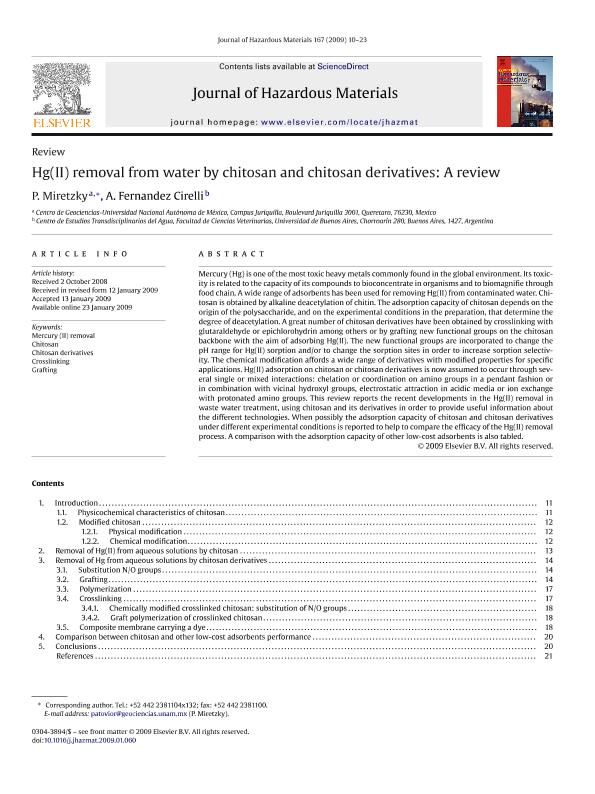Artículo
Hg(II) removal from water by chitosan and chitosan derivatives: A review
Fecha de publicación:
15/08/2009
Editorial:
Elsevier Science
Revista:
Journal of Hazardous Materials
ISSN:
0304-3894
Idioma:
Inglés
Tipo de recurso:
Artículo publicado
Clasificación temática:
Resumen
Mercury (Hg) is one of the most toxic heavy metals commonly found in the global environment. Its toxicity is related to the capacity of its compounds to bioconcentrate in organisms and to biomagnifie through food chain. A wide range of adsorbents has been used for removing Hg(II) from contaminated water. Chitosan is obtained by alkaline deacetylation of chitin. The adsorption capacity of chitosan depends on the origin of the polysaccharide, and on the experimental conditions in the preparation, that determine the degree of deacetylation. A great number of chitosan derivatives have been obtained by crosslinking with glutaraldehyde or epichlorohydrin among others or by grafting new functional groups on the chitosan backbone with the aim of adsorbing Hg(II). The new functional groups are incorporated to change the pH range for Hg(II) sorption and/or to change the sorption sites in order to increase sorption selectivity. The chemical modification affords a wide range of derivatives with modified properties for specific applications. Hg(II) adsorption on chitosan or chitosan derivatives is now assumed to occur through several single or mixed interactions: chelation or coordination on amino groups in a pendant fashion or in combination with vicinal hydroxyl groups, electrostatic attraction in acidic media or ion exchange with protonated amino groups. This review reports the recent developments in the Hg(II) removal in waste water treatment, using chitosan and its derivatives in order to provide useful information about the different technologies. When possibly the adsorption capacity of chitosan and chitosan derivatives under different experimental conditions is reported to help to compare the efficacy of the Hg(II) removal process. A comparison with the adsorption capacity of other low-cost adsorbents is also tabled. © 2009 Elsevier B.V. All rights reserved.
Palabras clave:
CHITOSAN
,
CHITOSAN DERIVATIVES
,
CROSSLINKING
,
GRAFTING
,
MERCURY (II) REMOVAL
Archivos asociados
Licencia
Identificadores
Colecciones
Articulos(OCA PQUE. CENTENARIO)
Articulos de OFICINA DE COORDINACION ADMINISTRATIVA PQUE. CENTENARIO
Articulos de OFICINA DE COORDINACION ADMINISTRATIVA PQUE. CENTENARIO
Citación
Miretzky, Patricia; Fernandez Cirelli, Alicia; Hg(II) removal from water by chitosan and chitosan derivatives: A review; Elsevier Science; Journal of Hazardous Materials; 167; 1-3; 15-8-2009; 10-23
Compartir
Altmétricas




